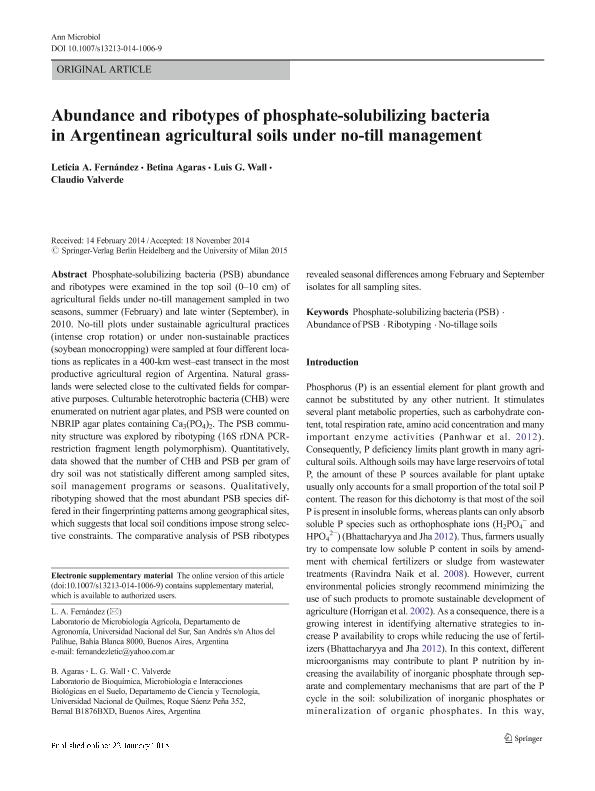Mostrar el registro sencillo del ítem
dc.contributor.author
Fernandez, Leticia Andrea

dc.contributor.author
Agaras, Betina Cecilia

dc.contributor.author
Wall, Luis Gabriel

dc.contributor.author
Valverde, Claudio Fabián

dc.date.available
2018-04-12T18:36:10Z
dc.date.issued
2015-09
dc.identifier.citation
Fernandez, Leticia Andrea; Agaras, Betina Cecilia; Wall, Luis Gabriel; Valverde, Claudio Fabián; Abundance and ribotypes of phosphate solubilizing bacteria in Argentinean agricultural soils under no-till management; Springer; Annals Of Microbiology; 65; 3; 9-2015; 1667-1678
dc.identifier.issn
1590-4261
dc.identifier.uri
http://hdl.handle.net/11336/41881
dc.description.abstract
Phosphate-solubilizing bacteria (PSB) abundance and ribotypes were examined in the top soil (0–10 cm) of agricultural fields under no-till management sampled in two seasons, summer (February) and late winter (September), in 2010. No-till plots under sustainable agricultural practices (intense crop rotation) or under non-sustainable practices (soybean monocropping) were sampled at four different locations as replicates in a 400-km west–east transect in the most productive agricultural region of Argentina. Natural grasslands were selected close to the cultivated fields for comparative purposes. Culturable heterotrophic bacteria (CHB) were enumerated on nutrient agar plates, and PSB were counted on NBRIP agar plates containing Ca3(PO4)2. The PSB community structure was explored by ribotyping (16S rDNA PCR-restriction fragment length polymorphism). Quantitatively, data showed that the number of CHB and PSB per gram of dry soil was not statistically different among sampled sites, soil management programs or seasons. Qualitatively, ribotyping showed that the most abundant PSB species differed in their fingerprinting patterns among geographical sites, which suggests that local soil conditions impose strong selective constraints. The comparative analysis of PSB ribotypes revealed seasonal differences among February and September isolates for all sampling sites.
dc.format
application/pdf
dc.language.iso
eng
dc.publisher
Springer

dc.rights
info:eu-repo/semantics/openAccess
dc.rights.uri
https://creativecommons.org/licenses/by-nc-sa/2.5/ar/
dc.subject
Solubilization
dc.subject
Phosporus
dc.subject
Bacteria
dc.subject
Diversity
dc.subject.classification
Otras Ciencias Biológicas

dc.subject.classification
Ciencias Biológicas

dc.subject.classification
CIENCIAS NATURALES Y EXACTAS

dc.title
Abundance and ribotypes of phosphate solubilizing bacteria in Argentinean agricultural soils under no-till management
dc.type
info:eu-repo/semantics/article
dc.type
info:ar-repo/semantics/artículo
dc.type
info:eu-repo/semantics/publishedVersion
dc.date.updated
2018-04-12T14:29:39Z
dc.identifier.eissn
1869-2044
dc.journal.volume
65
dc.journal.number
3
dc.journal.pagination
1667-1678
dc.journal.pais
Alemania

dc.description.fil
Fil: Fernandez, Leticia Andrea. Universidad Nacional del Sur. Departamento de Agronomía; Argentina
dc.description.fil
Fil: Agaras, Betina Cecilia. Universidad Nacional de Quilmes. Departamento de Ciencia y Tecnología. Laboratorio de Investigación en Interacciones Biológicas; Argentina. Consejo Nacional de Investigaciones Científicas y Técnicas; Argentina
dc.description.fil
Fil: Wall, Luis Gabriel. Universidad Nacional de Quilmes. Departamento de Ciencia y Tecnología. Laboratorio de Investigación en Interacciones Biológicas; Argentina. Consejo Nacional de Investigaciones Científicas y Técnicas; Argentina
dc.description.fil
Fil: Valverde, Claudio Fabián. Universidad Nacional de Quilmes. Departamento de Ciencia y Tecnología. Laboratorio de Investigación en Interacciones Biológicas; Argentina. Consejo Nacional de Investigaciones Científicas y Técnicas; Argentina
dc.journal.title
Annals Of Microbiology

dc.relation.alternativeid
info:eu-repo/semantics/altIdentifier/doi/http://dx.doi.org/10.1007/s13213-014-1006-9
dc.relation.alternativeid
info:eu-repo/semantics/altIdentifier/url/https://link.springer.com/article/10.1007%2Fs13213-014-1006-9
Archivos asociados
